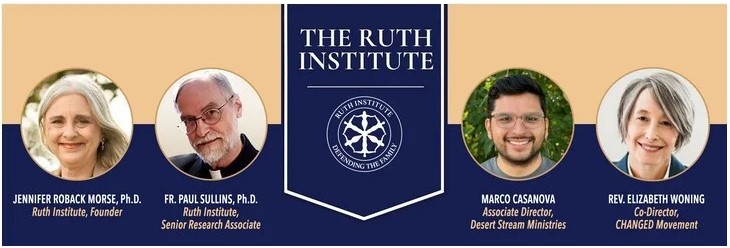According to Ruth Institute sociologist Father Paul Sullins, a generation of younger clergy formed for lives of chaste celibacy is a major reason why clergy
abuse rates are much lower than before 2000.
This article was first published June 10, 2019, at NCRegister.com.
by Peter Jesserer Smith
LAKE CHARLES, La. — Some promising news on the clergy sex-abuse crisis is joined by some warning signs, in a new report by religious sociologist
Father Paul Sullins and the Ruth Institute.
According to the report, the overall number of homosexual priests has declined sharply since a peak in the 1980s — and so have the number of
victims, who previously have been predominantly male. And it indicates that more recently ordained priests collectively have a far greater commitment
to orthodoxy than the preceding generation of the priesthood, including faithfully living out the Church’s teachings with respect to chastity.
However, it states that the reports of sex abuse have also risen somewhat after hitting a low in 2002 and that the majority of victims of current reports
within the last decade are likely to be female teenagers.
“Our long-standing interest at the Ruth Institute has been concern for the victims of the sexual revolution, of whom the victims of clergy sex abuse
certainly are a prime interest,” Ruth Institute President Jennifer Roback Morse told reporters on a media call Thursday presenting the report,
titled “Receding Waves: Child Sex Abuse and Homosexual Priests Since 2000.”
The Ruth Institute made four recommendations: continuing vigilance in protecting all minors against clerical sexual abuse; paying particular attention
to the persistent sexual abuse of girls; researching further into clergy self-description of their patterns of sexual attraction and behavior;
and increasing educational programs on authentic Church teaching on human sexuality, including St. John Paul II’s theology of the body, at “all
levels of education such as seminaries, universities, high schools, elementary schools, and parish catechism classes.”
Sociologist and Catholic priest Father Paul Sullins, who authored the report, found that since the 1960s priests engaged in child sex abuse have been
relatively concentrated in two age groups: one ordained in the late 1960s and the other ordained in the early 1980s. The report stated the pattern
of 20th-century clergy abuse of minors “closely tracks the estimates of numbers of self-identified homosexual clergy” and the decline of homosexual
clergy “roughly equals fewer cases of clergy sexual abuse” in the U.S.
His report admitted there is no concrete data on the number of ordained homosexual priests after 2000, but stated that “statistical projections estimate
that recent ordination classes have contained very few homosexual men.”
Father Sullins noted in the media call that the drop in ordinations of homosexual men is concurrent with the rise of a newer generation of young, orthodox
candidates for the priesthood coming through seminary.
According to the data Father Sullins analyzed on clerical sexual abuse alleged to have taken place since 2000, priests ordained within the past 10
years accounted for 11% of those recent abuse allegations. More than half (52%) of the recent alleged abuse was perpetrated by priests ordained
30 years ago or more.
Changing Picture of Sex Abuse
Father Sullins said the proportion of male and female victims is changing in recent abuse reports: Seventy-four percent of reported victims were male
in 2000 compared to only 34% by 2016.
The report highlights a “disturbing rise of the sexual abuse of children by priests after reaching an all-time low just after 2002.” While reports
of current abuse averaged 7.0 per year from 2005 to 2009, he said, they rose to 8.2 per year from 2010 to 2014, a 17% increase.
“We have more abuse today than a decade ago,” he said.
Morse said Catholics should not fool themselves that the sex-abuse crisis is limited to homosexual clergy. The Ruth Institute has a place for survivors
to tell their stories, and she said girls were by far the largest group telling their stories.
Still, Father Sullins said the overall abuse rate is well below the 1980s, when there were an average of 26.2 reports of current abuse per year.
Father Sullins clarified on the media call that the numbers from current reports only reflect trends, not the total numbers of abuse victims. The scope
of the abuse crisis in real numbers is difficult to quantify. He said abuse victims on average take 28 years to process and report. Even then,
he told reporters, only three or four victims out of 10 will come forward.
Father Sullins noted also that the national review board is warning about this very thing, pointing to rising complacency, failure to implement proper
screening procedures, and failures to update trainings of adults and children at the diocesan and parish level on possible harms.
At the same time, Father Sullins stated that the rate of abuse in Catholic settings is “much lower” than comparable secular settings. He cautioned
against the idea that “clergy sex abuse is a thing of the past.”
Critical Reception
However, the Ruth Institute report has drawn criticism. Mark Gray, director of CARA Catholic Polls and a senior research associate at Georgetown University’s
Center for Applied Research in the Apostolate, told the Register he is concerned that a substantial
part of Father Sullins’ data cannot be independently examined.
The data Father Sullins cited from the site VictimsSpeakDB is no longer available online.
Gray said it seemed “deeply suspicious” to him the researcher who compiled it would cite “limited interest in statistical data about clergy sex
abuse in the Catholic Church” as his reason for taking the data offline.
Gray said most sociologists and criminologists would disagree with Father Sullins’ conclusions indicating a connection between the rise and fall of
homosexual men in the priesthood and the rise and fall of sexual abuse cases.
“The consensus among researchers who study abuse is that sexual orientation is not a causal factor,” he said.
While there are no doubt specific factors for why the cohort of priests who committed acts of abuse, concentrated between the 1960s and 1980s, were
abusers, Gray said there is no single cause, such as active homosexuality, that would be sufficient to explain the phenomenon.
Further Studies Needed
Both Father Sullins and Gray stated the Church does not have any studies that could give meaningful data on clerical sexual activity, or even whether
that sexual activity varies depending on settings involving different levels of supervision and mutual accountability: such as whether the priest
lives alone, with other priests in a rectory, or in a monastic setting.
Understanding the sexual activity of celibate clergy is key to understanding the phenomenon of clerics who sexually abuse minors and even adults. Stephen
De Weger, an Australian researcher of adult sexual abuse, told the Register that elastic definitions of celibacy among the clergy are a component
to the crisis.
He noted the most concentrated eras of documented sexual abuse correlate with a certain zeitgeist in seminary that was reacting against a
previous culture of repressed sexuality. Books in vogue between the 1960s and 1980s stressed that clergy were “sexual beings,” which, De Weger
said, may have given a vast number of psycho-sexually immature men (and women) in religious and clerical life a kind of permission to engage in
sexual activity, and to justify it as normal, or an expression of love. Many others, he said, such as serial-offender types, “simply consciously
take advantage of their positional power and use such terms as ‘God approves because this is love and God is love.’”
De Weger, who had briefly been in religious life during this time, indicated that some of these works seemed “a short step from the sexual celibate
to the sexually active celibate.”
One popular book, he noted, outlined several different “expressions of celibacy” that basically gave justifications for different kinds of sexual contact
under the guise of maintaining one’s promises or vows. However, for the faithful who expect that celibates are living chastity, “this makes no
sense at all” and also exposes the faithful to potential harm.
De Weger said his research strongly found that because Catholic faithful expect the clergy they turn to for spiritual help and guidance will not sexualize
their spiritual relationships, they are vulnerable to that abuse of power and breach of trust.
Father Sullins said he’s encountered those elastic rationalizations in the older generations of priests and religious. One factor behind why incidents
of sexual abuse are lower in younger priests, he said, may be due to how celibacy is taught now in seminary by priests who are now fully molded
in St. John Paul II’s theology.
He said celibacy in the theology of the younger clergy is not simply about not having physical sex or being unmarried, but rather is a “conscious relinquishment
of marriage and the prerogatives of marriage for the sake of the Kingdom of God.”
Moving Forward
Mary Hasson, president of the Catholic Women’s Forum, told the Register that the Ruth Institute’s report helps the Church to “better understand what
went wrong” and the critical importance of “sound human formation” for the priesthood.
While it is “good news” that the number of abuse cases has dropped, it is a vital reminder that Catholics cannot be any less vigilant or urgent about
dealing with the abuse crisis, and there are both adults and children who have been victimized by clergy.
Hasson said she’d like to see the U.S. bishops at their assembly next week in Baltimore give a “demonstration of their resolve” to face the crisis
and recommended they implement lay-involved “accountability and transparency” mechanisms, such with the lay review board, so the Church can move
forward.
“There’s a wide range of victims,” she said. “We can’t rest until there are none.”



